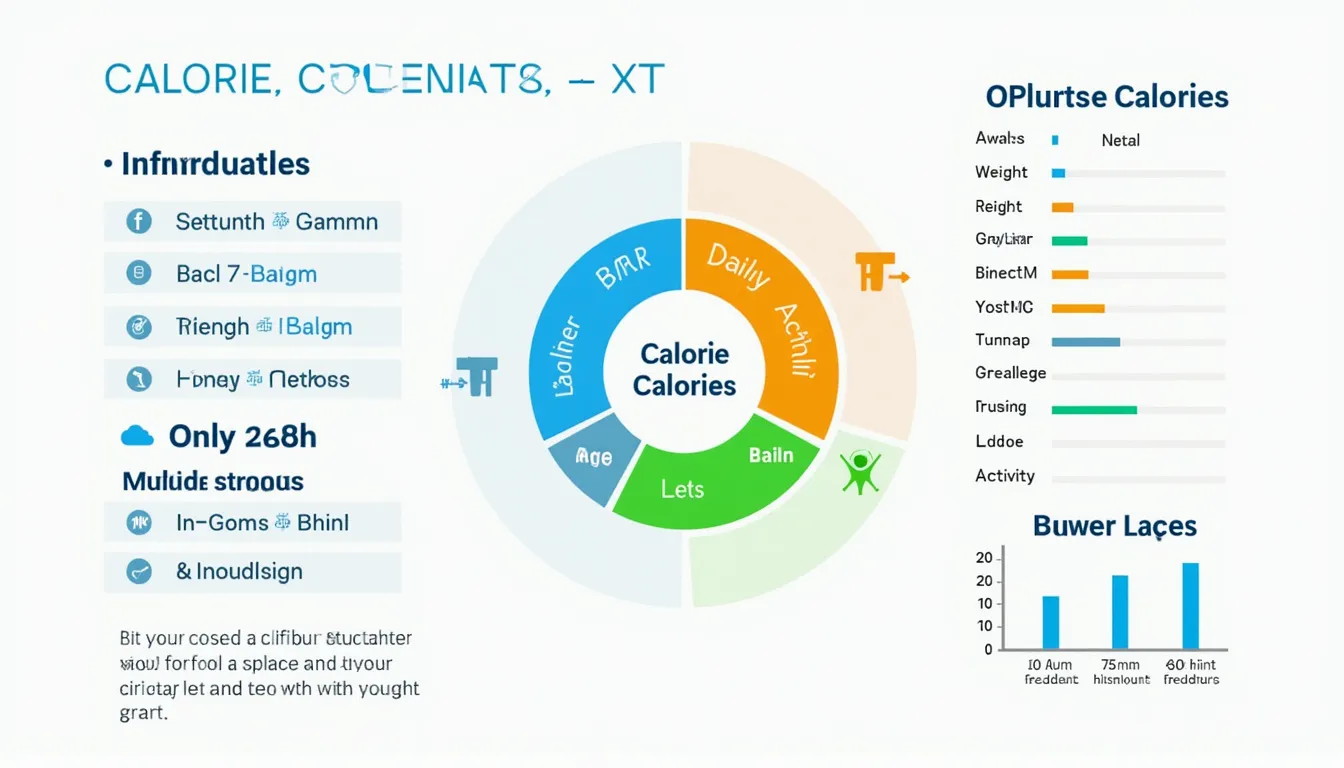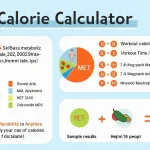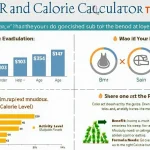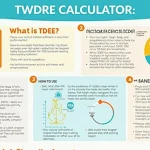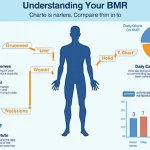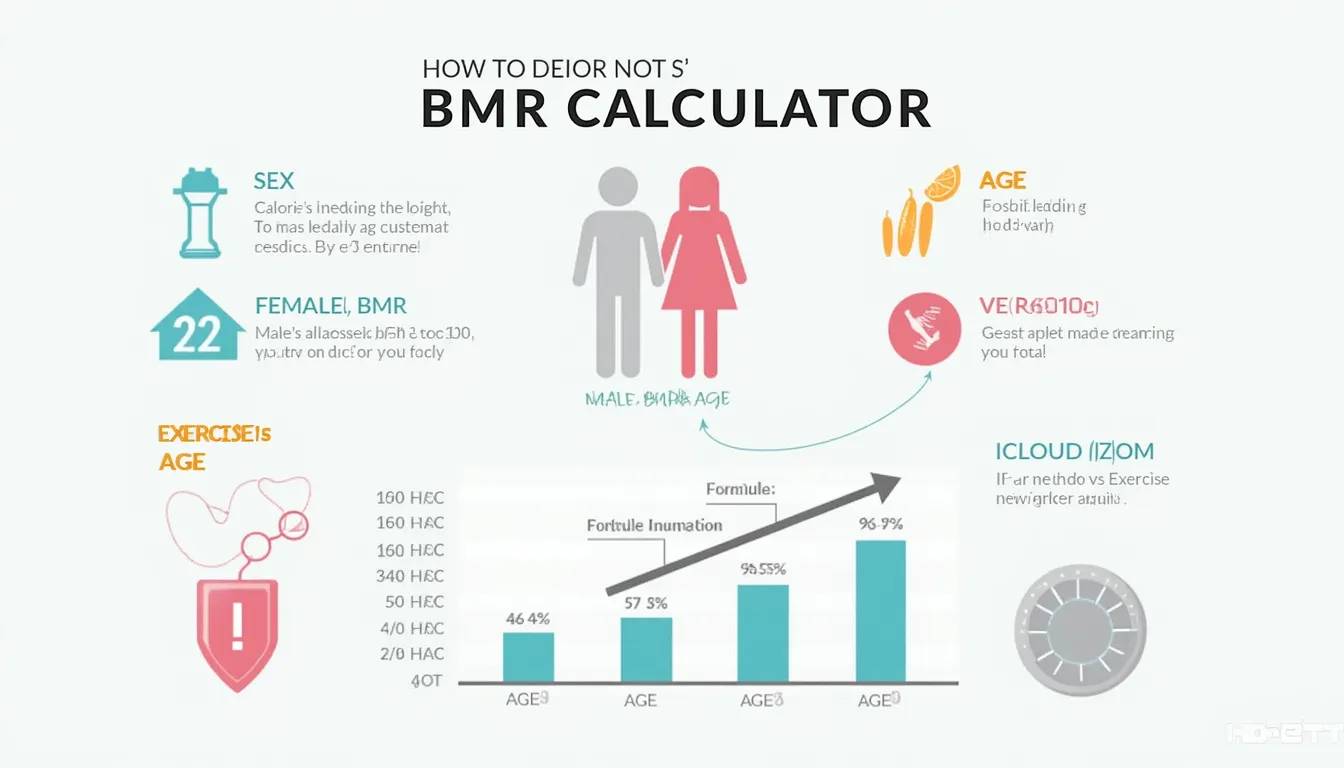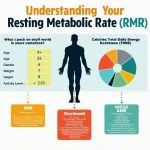Calorie Calculator
Is this tool helpful?
How to Use the Calorie Calculator Effectively
This advanced Calorie Calculator is designed to help you determine your precise daily caloric needs based on your personal attributes and activity levels. To get accurate and personalized results, follow these steps carefully:
- Enter your age: Input your age in years, for example, 29 or 45. The accepted range is from 1 to 120 years.
- Provide your weight: Enter your weight in kilograms, such as 68.5 kg or 92 kg.
- Input your height: Specify your height in centimeters, like 175 cm or 182 cm.
- Select your gender: Choose either male or female from the dropdown for gender-specific calculations.
- Enter your MET value: MET (Metabolic Equivalent of Task) measures workout intensity; examples include 6 (moderate cycling) or 10 (vigorous running).
- Specify workout duration: Enter the number of hours you spend exercising daily, for example, 1.5 hours or 2.25 hours.
- Input daily activity calories: Enter the estimated calories burned through your daily activities besides exercise, such as 400 kcal or 750 kcal.
- Click “Calculate”: The calculator processes your inputs and presents detailed results including your Basal Metabolic Rate, calories burned during workouts, Total Daily Energy Expenditure, and tailored nutritional recommendations.
By accurately filling in all fields, you receive precise caloric calculations tailored to your unique physiology and lifestyle, empowering you to optimize diet and fitness strategies effectively.
Understanding the Calorie Calculator: Definition, Purpose, and Benefits
The Calorie Calculator is a sophisticated digital tool that estimates your daily energy requirements using the widely accepted Harris-Benedict equation. It integrates critical personal factors such as age, gender, weight, height, and physical activity levels to provide an accurate assessment of your caloric needs.
This tool is designed to:
- Calculate your Basal Metabolic Rate (BMR): the calories your body requires at rest to maintain vital functions.
- Assess calories burned during workout sessions: based on your exercise intensity and duration.
- Determine Total Daily Energy Expenditure (TDEE): combining all calorie expenditures for the day.
- Offer personalized nutritional guidance: to help maintain, gain, or lose weight effectively.
By leveraging these insights, the Calorie Calculator supports informed decisions about nutrition and fitness, helping users meet their health objectives with precision and confidence.
Example Calculations: How the Calorie Calculator Works
This JavaScript-based calculator uses specific formulas to process your data and present clear calorie benchmarks. Here’s how it calculates key values:
Basal Metabolic Rate (BMR) Formulas
The calculator applies the Harris-Benedict equations, which vary by gender:
For males: $$ BMR = 66 + (13.7 \times weight_{kg}) + (5 \times height_{cm}) – (6.8 \times age_{years}) $$
For females: $$ BMR = 665 + (9.6 \times weight_{kg}) + (1.8 \times height_{cm}) – (4.7 \times age_{years}) $$
Calculating Workout Calories Burned
Calories burned during exercise are estimated by multiplying your MET value, workout duration in hours, and weight:
$$ Workout\,Calories = MET \times workout_{hours} \times weight_{kg} $$
Total Daily Energy Expenditure (TDEE)
Finally, your total daily calorie needs are the sum of your BMR, workout calories, and daily activity calories:
$$ TDEE = BMR + Workout\,Calories + Daily\,Activity\,Calories $$
After performing these calculations, the tool provides results along with recommendations:
- Caloric intake to maintain current weight
- Suggested caloric surplus for muscle gain (typically 500 kcal above maintenance)
- Recommended caloric deficit for fat loss (typically 500 kcal below maintenance)
Consistency and adherence to these tailored recommendations are essential for achieving your fitness goals efficiently.
Practical Benefits of Using the Calorie Calculator for Your Fitness Journey
Incorporating this Calorie Calculator into your daily routine offers numerous advantages to optimize your nutritional strategy:
- Customized caloric guidance: Receive calorie recommendations based specifically on your unique physiological data.
- Enhanced weight management: Precisely control calorie intake to lose, gain, or maintain weight effectively.
- Optimized muscle building: Establish the correct calorie surplus to support lean muscle growth without excess fat gain.
- Efficient fat loss planning: Create accurate calorie deficits to lose body fat safely while preserving muscle mass.
- Improved workout nutrition: Align your caloric intake with exercise intensity and duration for better performance and recovery.
- Insight into energy balance: Understand the dynamic relationship between calories consumed and calories burned for better nutritional balance.
- Goal-specific recommendations: Tailored advice for athletes, bodybuilders, and fitness enthusiasts.
- Time-saving and easy to use: Obtain quick calorie calculations without manual effort.
- Motivation enhancement: Setting clear calorie targets enhances commitment to your diet and training plan.
- Progress monitoring: Regular recalculations help track changes in metabolism and energy needs over time.
Practical Use Cases: Real-Life Applications of the Calorie Calculator
1. Weight Loss Planning
Jane, a 30-year-old office worker, wants to reduce body fat. Using the calculator, she determines:
- BMR: 1,350 kcal
- Workout calories (1 hour yoga): 150 kcal
- Daily activity: 350 kcal
- TDEE: 1,850 kcal
To lose weight healthily, Jane sets a daily intake target of about 1,350 kcal (a 500 kcal deficit), aiming for sustainable fat loss.
2. Muscle Gain for Athletes
David, a 25-year-old athlete, uses the calculator during his muscle-building phase:
- BMR: 1,900 kcal
- Workout calories (2 hours intense lifting): 700 kcal
- Daily activity: 500 kcal
- TDEE: 3,100 kcal
David aims for a 500 kcal surplus, consuming about 3,600 kcal daily to fuel muscle growth effectively.
3. Endurance Athlete Nutrition
Samantha, training for a triathlon, calculates her caloric needs:
- BMR: 1,400 kcal
- Workout calories (daily swim and run): 900 kcal
- Daily activity: 400 kcal
- TDEE: 2,700 kcal
She focuses on consuming around 2,700 kcal daily to maintain energy and perform optimally during intense training periods.
4. Postpartum Weight Management
Maria, a new mother, uses the calculator to safely lose pregnancy weight:
- BMR: 1,450 kcal
- Workout calories (light walking): 250 kcal
- Daily activity (childcare, chores): 550 kcal
- TDEE: 2,250 kcal
She targets a moderate 300 kcal deficit, consuming about 1,950 kcal daily to encourage steady, healthy weight loss.
5. Senior Nutrition and Health
John, 68 years old, maintains health with tailored nutrition:
- BMR: 1,200 kcal
- Workout calories (daily light exercise): 300 kcal
- Daily activity: 400 kcal
- TDEE: 1,900 kcal
He focuses on consuming nutrient-dense foods to meet his daily 1,900 kcal requirement, supporting energy and healthy aging.
Frequently Asked Questions (FAQs) About the Calorie Calculator
1. How accurate is the Calorie Calculator?
This calculator uses scientifically backed formulas and provides a reliable estimate of your caloric needs. Individual variations due to metabolism or lifestyle may cause slight differences. Use the results as a guide and adjust based on your actual progress.
2. How often should I update my calorie calculations?
Recalculate every 4-6 weeks or when significant changes occur in your weight, activity, or goals to ensure your nutrition remains optimized.
3. What is MET, and how do I find my MET value?
MET (Metabolic Equivalent of Task) quantifies exercise intensity. One MET equals the energy used while resting. You can find MET values for various activities through fitness resources or online databases. For instance, walking at 3 mph is about 3.3 METs, while vigorous swimming is around 8 METs.
4. Can pregnant or breastfeeding women use this calculator?
While it provides a general baseline, pregnant and nursing mothers should consult healthcare professionals for personalized nutrition tailored to their unique needs.
5. How do I factor in a physically demanding job?
Include estimated calories burned during work in the “Daily Activity” field to better reflect your total energy expenditure.
6. Should I eat exactly the calories the calculator recommends?
The recommended calories align with your goals—feel free to adjust slightly for comfort, but avoid drastic changes to ensure effective and safe progress.
7. Does the calculator account for muscle mass?
Indirectly, yes. Since muscle mass influences weight and activity expenditure, it factors into overall calorie needs, although it doesn’t measure muscle directly.
8. Is this calculator suitable for people with metabolic disorders?
It offers a general estimate, but individuals with conditions affecting metabolism should seek tailored advice from healthcare providers.
9. What should I do if I don’t see results?
Adjust your daily calorie intake by increments of 100-200 kcal based on your goal, then monitor progress over a few weeks and fine-tune as needed.
10. Can children use this calculator?
This tool is intended for adults. Children’s caloric needs differ significantly and should be evaluated by pediatric specialists or dietitians.
Conclusion: Empower Your Nutritional Journey with Precision
Using this detailed Calorie Calculator equips you with scientifically grounded insights into your daily energy requirements. By tailoring calorie recommendations based on your unique profile and lifestyle, you can effectively plan your nutrition to maintain, build, or lose weight while optimizing fitness results.
Whether you’re a casual exerciser, competitive athlete, or managing health conditions, this tool empowers you to take control of your diet with confidence and clarity. Remember, consistency paired with informed choices leads to sustainable progress and long-term success.
Important Disclaimer
The calculations, results, and content provided by our tools are not guaranteed to be accurate, complete, or reliable. Users are responsible for verifying and interpreting the results. Our content and tools may contain errors, biases, or inconsistencies. Do not enter personal data, sensitive information, or personally identifiable information in our web forms or tools. Such data entry violates our terms of service and may result in unauthorized disclosure to third parties. We reserve the right to save inputs and outputs from our tools for the purposes of error debugging, bias identification, and performance improvement. External companies providing AI models used in our tools may also save and process data in accordance with their own policies. By using our tools, you consent to this data collection and processing. We reserve the right to limit the usage of our tools based on current usability factors.
